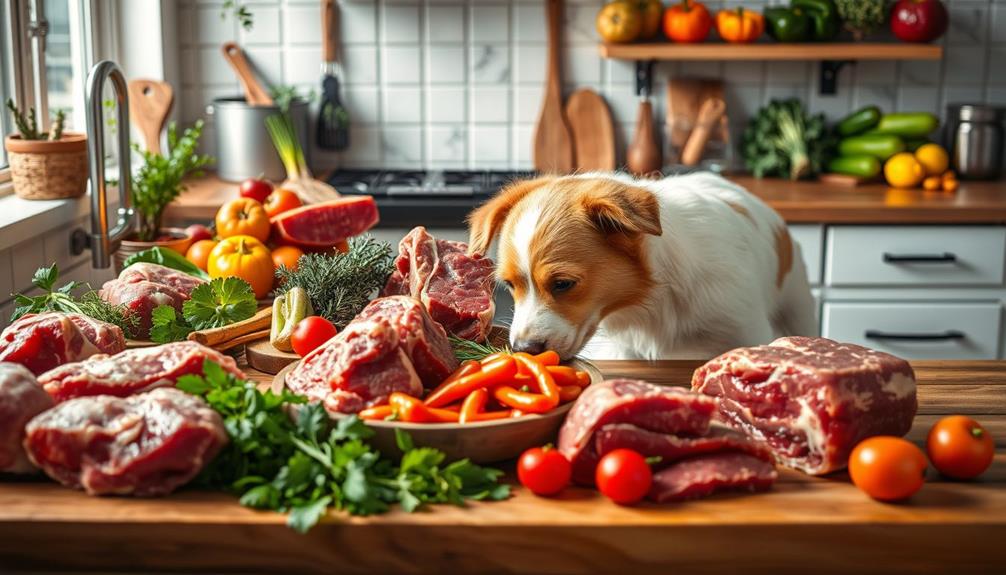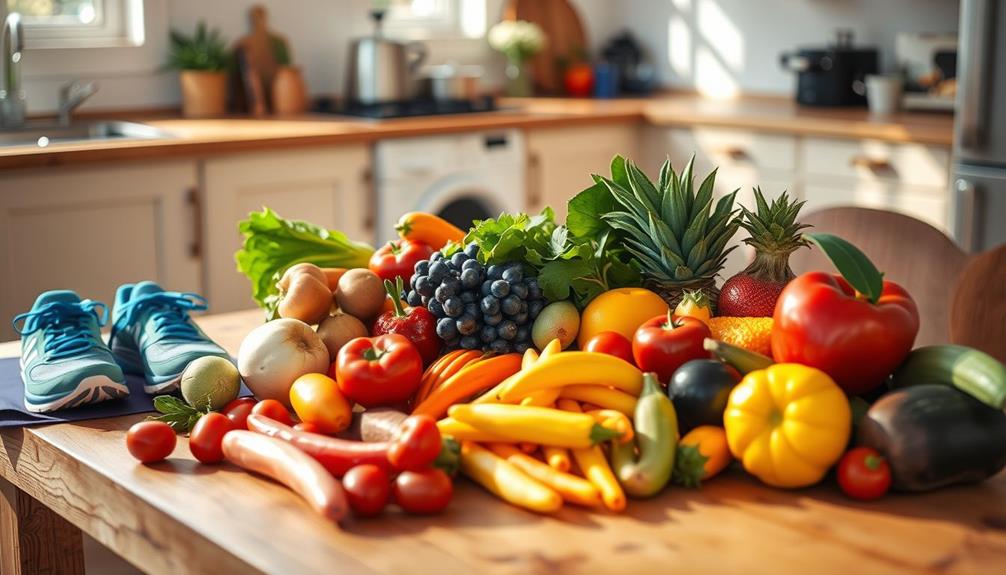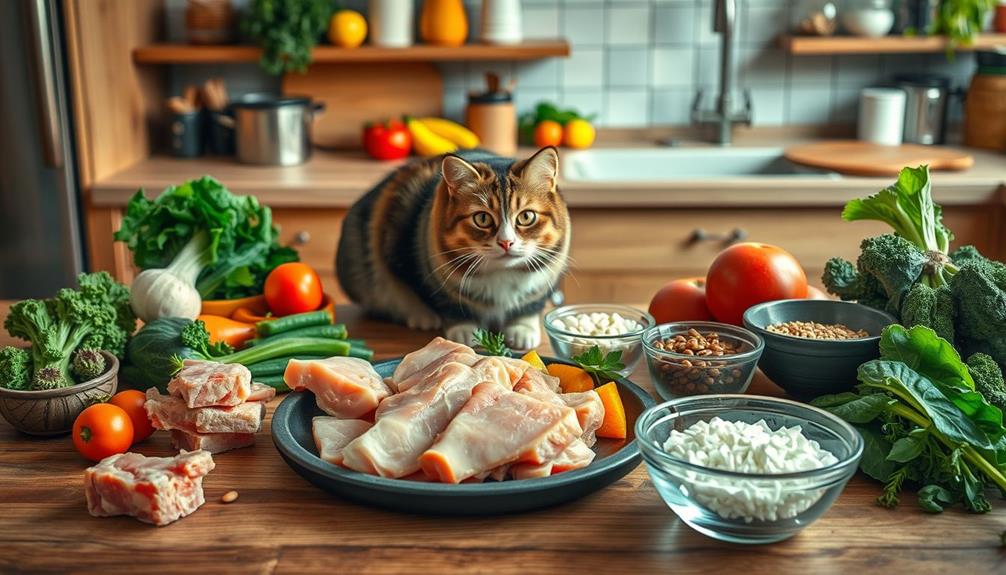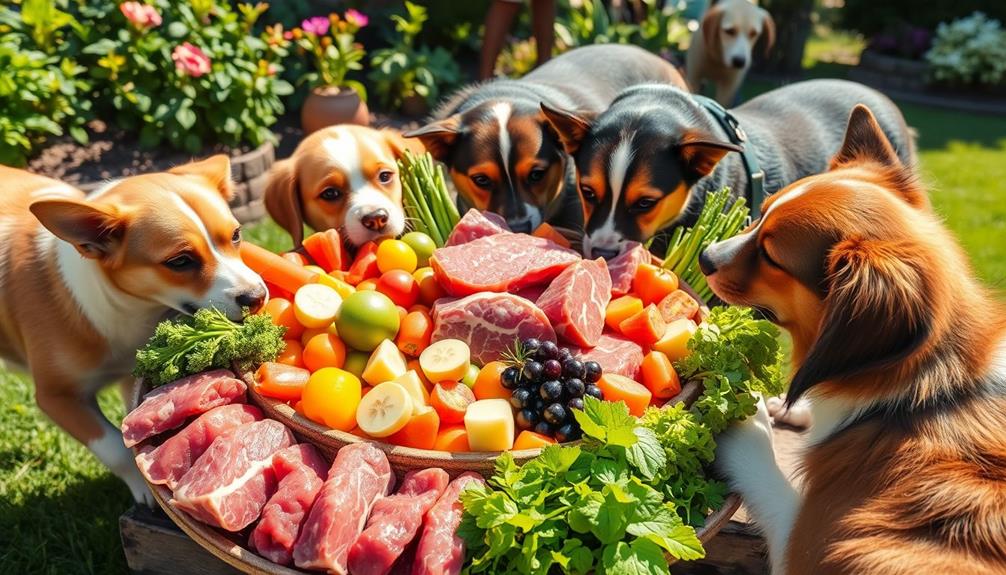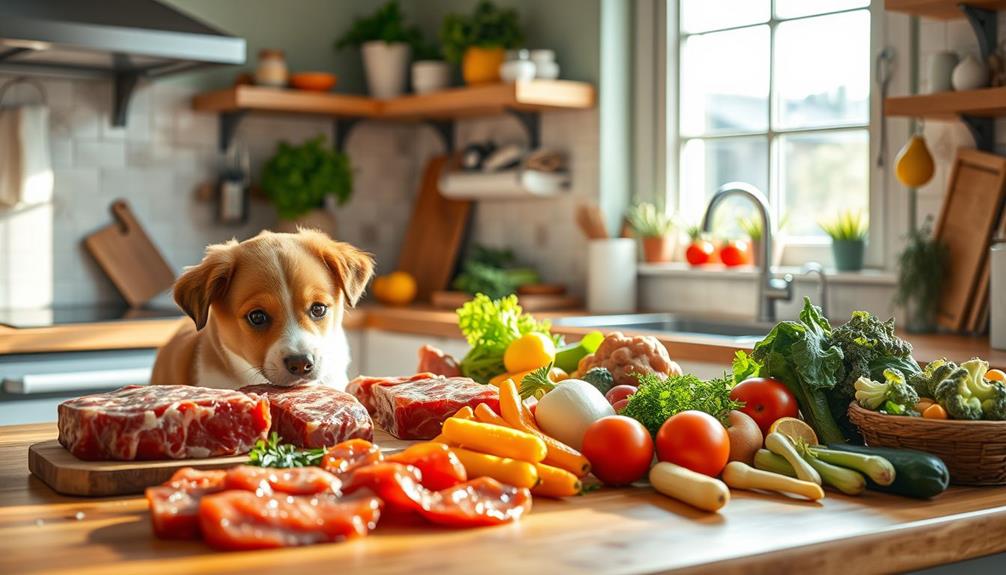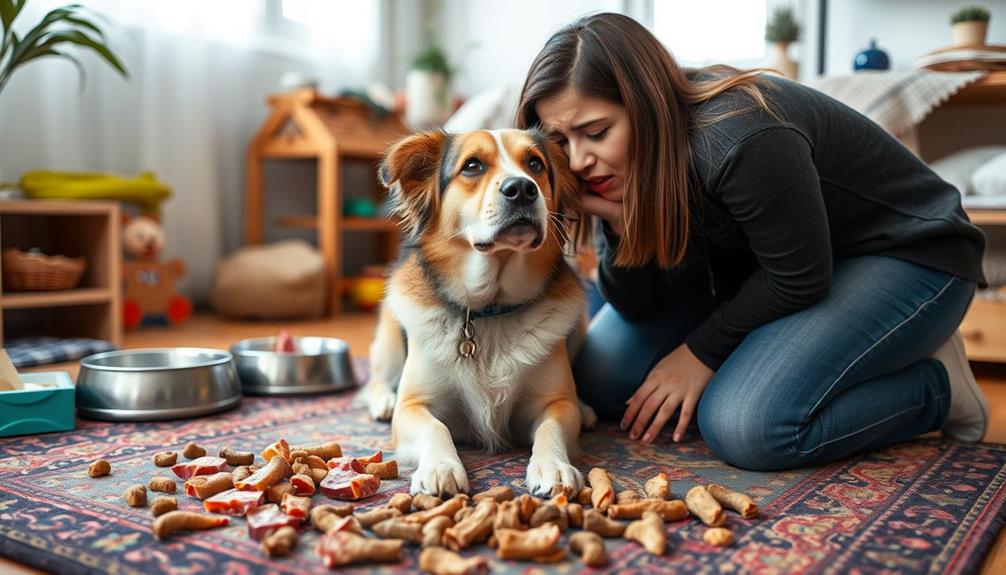To determine how much raw food your dog needs, start by feeding about 2% to 3% of their body weight daily. For smaller dogs, aim for 5-6%. Splitting meals into two portions helps with digestion. Active dogs may require more based on their energy levels, so keep an eye on their weight. If you're shifting to a raw diet, begin with 25% raw food for two weeks and expect some digestive adjustments. Using a raw food calculator can further tailor your dog's diet to their needs. Keep exploring to discover how to maintain ideal health for your furry friend! Raw food costs for dogs can vary depending on the quality and source of the food. It’s important to budget for this as part of your overall pet care expenses. You may find that purchasing in bulk or finding local suppliers can help reduce costs. Also, consider the long-term health benefits of a raw food diet for your dog, which can potentially save on vet bills and contribute to a longer, healthier life for your pet.
Key Takeaways
- Feed approximately 2% to 3% of your dog's body weight in raw food daily, adjusting based on energy levels and activity.
- Small dogs (up to 5 lbs) require about 5-6% of their body weight in raw food for proper nutrition.
- Gradually transition to a raw diet by starting with 25% raw and 75% old food, increasing the raw portion over two weeks.
- Use a raw feeding calculator to determine daily intake based on your dog's ideal body weight and dietary needs.
- Monitor your dog's weight and stool consistency to adjust portions and ensure a balanced diet.
Benefits of a Raw Diet
When you switch your dog to a raw diet, you'll likely notice a range of benefits that can enhance their overall health. One major advantage is improved digestion, leading to better nutrient absorption and smaller stool volume. This efficient digestion means your dog gets more out of their food, which can translate to enhanced energy levels and overall liveliness.
Additionally, a raw diet may help reduce the risk of certain health issues, as it often consists of natural ingredients that can support a dog's immune system the importance of selecting the right cold medication.
You might also find that a raw diet helps reduce allergies and skin issues in your dog. Many owners report healthier skin and a shinier coat after making the switch.
The benefits of raw don't stop there; this diet can also support better dental health. Chewing on raw meat naturally helps reduce plaque and tartar buildup, keeping your dog's teeth cleaner and healthier.
Even incorporating just 25% raw food into your dog's diet can greatly improve their comfort and decrease allergy symptoms. As you explore the benefits of a raw diet, you'll likely see your furry friend thriving with increased energy and a healthier appearance.
This dietary change could be a game-changer for your dog's overall well-being.
Portion Guidelines for Dogs
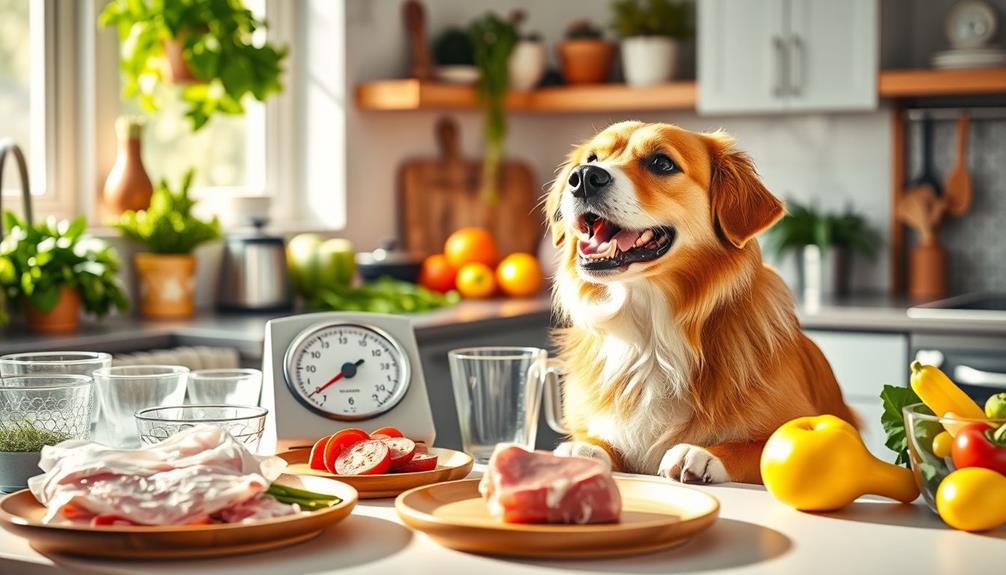
Determining the right portion size for your dog on a raw diet is fundamental for their health and well-being. Generally, you'll want to feed your dog about 2% to 3% of their body weight in raw food each day. For instance, if your dog weighs 25 pounds, that equates to approximately 0.5 pounds (8 ounces) of raw food daily. Providing healthy dog snacks alongside their raw diet can also promote overall wellness.
When it comes to smaller dogs, they require a higher percentage of their weight—typically around 5-6% for those up to 5 pounds.
It's important to remember that the daily portion should ideally be divided into two meals for adult dogs, which many owners find beneficial.
If your dog is particularly active, you might need to increase their food intake. Always monitor their weight and health, and adjust portions accordingly to guarantee they maintain an ideal weight.
Starting a Raw Diet
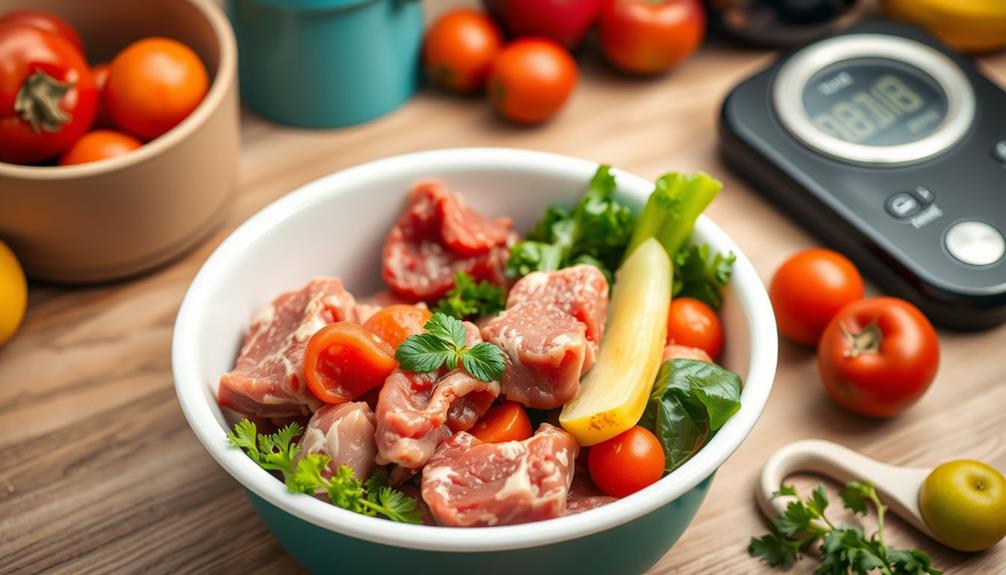
Starting a raw diet for your dog can be an exciting adventure, but it's important to approach it thoughtfully. Begin by shifting to raw food gradually. Start with a mix of 25% raw and 75% of their old food, slowly increasing the raw portion over about two weeks. This gradual change helps your dog adjust better and reduces potential digestive issues.
Ensuring that the raw diet includes a variety of proteins and nutrients is vital for your dog's overall health; proper diet includes fresh fruits and vegetables. To determine the appropriate daily intake, use a raw feeding calculator. Generally, you should aim for 2-3% of your dog's ideal body weight, splitting this into two meals. Prepackaged raw meals can simplify this process, ensuring you provide balanced, hormone-free, and antibiotic-free nutrition. Additionally, it’s important to note that raw food for puppies may have different nutritional requirements than adult dogs. It’s crucial to consult with a veterinarian or canine nutritionist to ensure that the raw diet is appropriate and balanced for your puppy’s growth and development. You may need to adjust the protein and nutrient levels to meet the needs of a growing puppy.
As you make this shift, closely monitor for any digestive issues. It's important to observe how your dog reacts to the new diet. If you notice any concerns, don't hesitate to consult with a veterinarian. They can help tailor the raw diet to your dog's specific health needs and guide you in determining the right amount of raw food.
Being attentive and informed will make starting a raw diet a successful journey for you and your furry friend.
Factors Influencing Dog's Diet
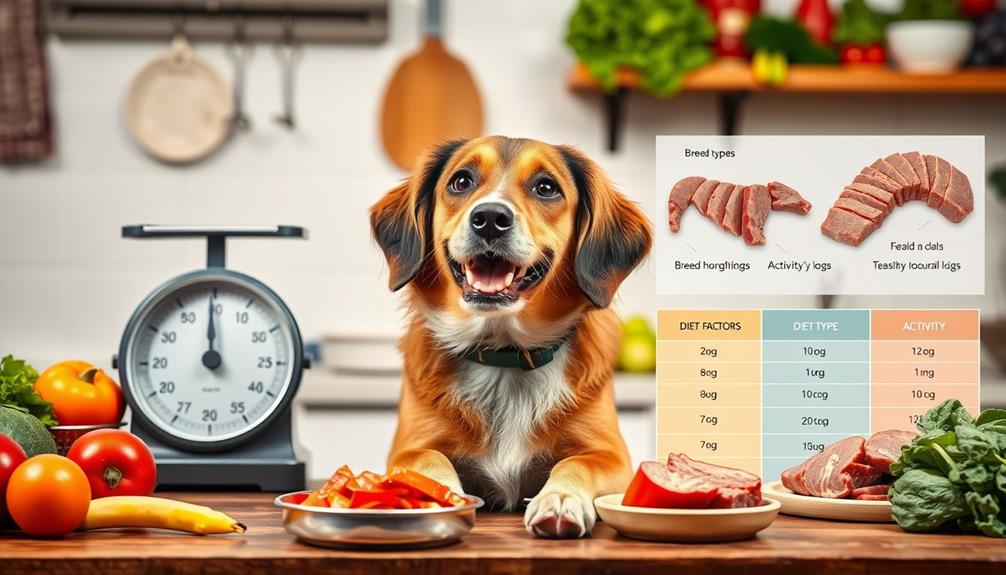
When it comes to your dog's diet, factors like activity level, age, and breed play an essential role.
For instance, active dogs need more food compared to their less active counterparts, and puppies or nursing dogs have even higher requirements.
Additionally, just as with infants, introducing unique beetroot recipes can be beneficial for boosting nutrition in a dog's diet.
Understanding these influences will help you tailor their diet for ideal health and well-being.
Activity Level Considerations
Understanding your dog's activity level is vital for meeting its dietary needs effectively. Active dogs typically require about 3% of their ideal adult weight in raw food daily, while those at their ideal weight need around 2-2.5%. If your dog weighs between 5-10 lbs, you may need to feed them a higher percentage—4-5% of their body weight—compared to larger breeds, which generally require less.
Additionally, factors such as age, health condition, and financial considerations for elderly care can influence overall care decisions, including diet.
To determine how much raw food to feed your dog, consider their activity level alongside their weight. Regular monitoring of your dog's weight and health is fundamental. As their activity level changes, you might need to adjust the amount of food you provide.
Additionally, factors like breed, metabolic rate, and environmental temperature can influence your dog's overall caloric needs, requiring further adjustments in their raw food diet.
For personalized advice tailored to your dog's unique activity level and any specific health concerns, it's wise to consult with an integrative veterinarian. They can help you guarantee that your dog gets the right amount of food to support their lifestyle and maintain peak health.
Age and Breed Impact
Age and breed greatly influence your dog's dietary requirements, so it's vital to tailor their food intake accordingly. For instance, if you're feeding your puppy, you'll need to provide 2-3 times the amount of food compared to an adult dog of the same body weight.
Smaller breeds often require a higher percentage of their body weight for food intake, needing about 5-6% for dogs up to 5 lbs, while larger breeds need less. Understanding your dog's investment goals can also help you make informed decisions about their nutrition as they grow.
The metabolic rate of your dog, greatly impacted by both age and breed, will dictate how much food they need. Active dogs burn more calories, so you must adjust their portions to prevent weight gain.
Special considerations apply if you have a pregnant or nursing dog, as they may require an intake of 5-10% of their body weight daily to support their health and their puppies.
To guarantee your dog thrives on a raw dog food diet, it's vital to calculate the appropriate portions based on their specific needs.
Regularly monitoring your dog's weight and health will help you make necessary adjustments to their diet as they age.
Feeding Guidelines for Puppies
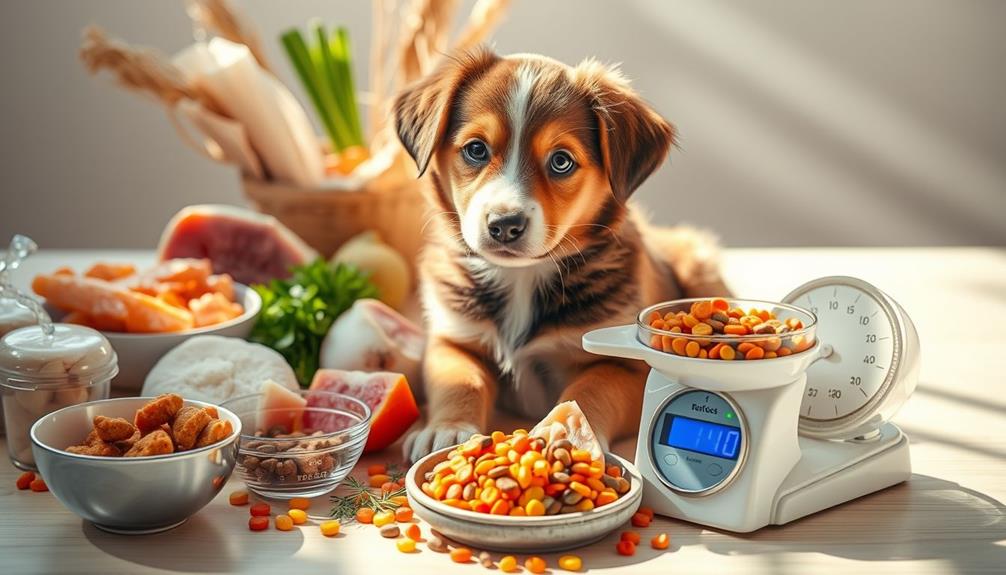
Puppies have unique nutritional needs that demand special attention from their owners. To guarantee your puppy receives the right amount of raw dog food for their growth and development, follow these feeding guidelines:
It's important to provide a balanced diet rich in nutrients, as a lack of essential elements can lead to health issues. Additionally, puppies can benefit from nutritional benefits such as high fiber and vitamins found in certain raw foods.
- Feeding Frequency: Very young puppies should be fed 3-4 times a day, while older puppies typically thrive on two meals per day.
- Portion Size: Aim to feed about 10% of their current weight or 2-3% of their ideal adult weight in raw food per meal.
- Monitor Growth: Keep a close eye on your puppy's growth. Adjust the amount you feed as they develop to guarantee they're getting a balanced diet.
- Helpful Supplements: Consider incorporating supplements like fish oil, kefir, apple cider vinegar, and pre/probiotics to boost your puppy's overall health.
Transitioning to Raw Food
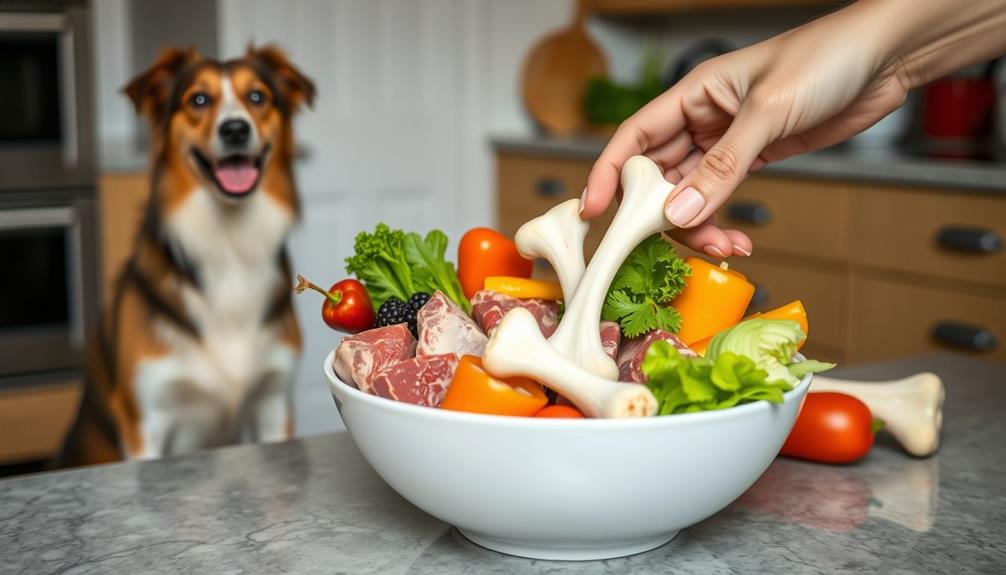
Shifting your dog to a raw food diet can be a rewarding experience, but it requires careful planning to guarantee a smooth adjustment. Start the changeover to raw food process over 1-2 weeks, beginning with a mix of 25% raw and 75% old food for the first few days. Gradually increase the raw portion while monitoring your dog's stool consistency. Normal stool indicates it's time to move to the next phase.
Incorporating fresh, whole ingredients can enhance your dog's overall health, similar to how certain essential oils for respiratory health support well-being.
It's common for dogs to experience initial loose stools or digestive upset during this change. These symptoms usually resolve as your dog's system adapts to the new diet. If your dog shows signs of discomfort or straining, consider a slower changeover process.
For picky eaters or pets with sensitive stomachs, extending each change step by a few days allows for proper adjustment. If issues persist, don't hesitate to seek tailored advice from your veterinarian. They can provide guidance tailored to your dog's specific needs, ensuring a successful shift to raw food without unnecessary stress or health concerns.
With patience and vigilance, you'll help your dog thrive on a nutritious raw diet.
Raw Food Calculator Usage
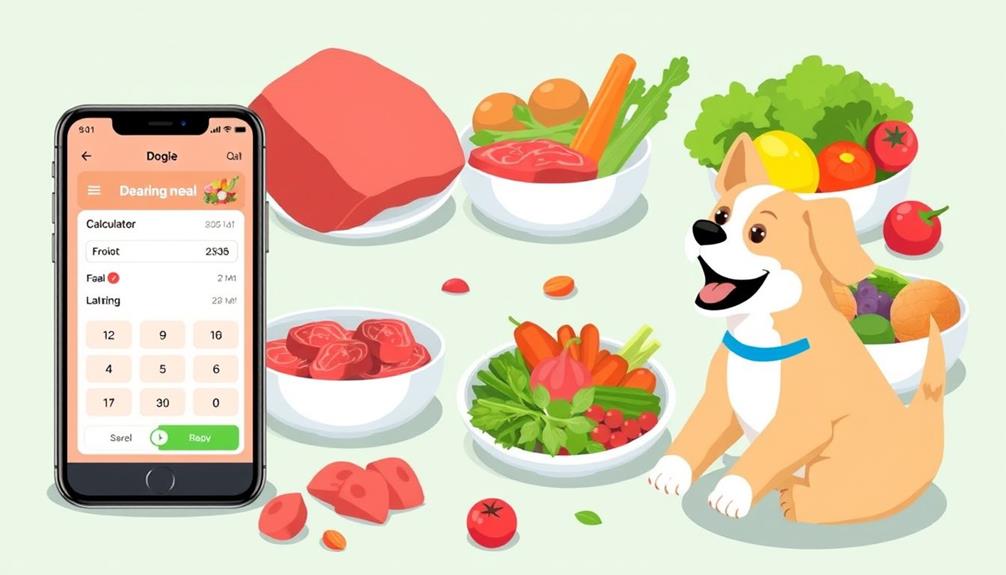
Determining the right amount of raw food for your dog is vital, and using a raw food calculator can simplify this process. A balanced diet is essential for your dog's overall health, much like how effective strategies for weight loss emphasize sustainability and moderation.
Here's how to use it effectively:
- Input Your Dog's Weight: Start by entering your dog's weight in pounds into the raw food calculator. This gives you a baseline recommendation for feeding.
- Select the Percentage of Raw Food: Adjust the percentage of the total diet that consists of raw food, usually between 10% and 100%, depending on your dog's specific dietary needs.
- Calculate Food Weight: The calculator uses the formula: (Dog's weight) x (percentage) = (Food weight in pounds).
- Monitor and Adjust: Keep an eye on your dog's health and adjust the portions as needed. Remember, the calculator offers guidelines, not strict rules.
For active dogs, you may need to increase the food intake beyond the calculator's recommendations due to their higher energy expenditure.
Using a raw food calculator is a great way to guarantee your adult dogs get the right diet tailored to their lifestyle!
Frequently Asked Questions
How Much Raw Food Should I Feed My Dog Chart?
To determine how much raw food to feed your dog, you can refer to a chart that considers their weight and activity level. Adjust portions based on their needs, monitoring their health regularly.
How Much Raw Food Does My Dog Need a Day?
Imagine your dog devouring mountains of raw food! In reality, feed them 2-3% of their ideal weight daily, split into two meals. Monitor their activity and adjust portions to keep them healthy and happy.
What Is the 80 10 10 Rule for Raw Dog Food?
The 80 10 10 rule means you should feed your dog 80% muscle meat, 10% organ meat, and 10% bone. This balance guarantees they get essential nutrients for ideal health and liveliness.
How to Calculate Raw Diet for Dogs?
You've got to crunch some numbers! To calculate your dog's raw diet, multiply their weight by 0.02 to 0.03 based on activity level. Adjust as needed, keeping an eye on their weight and health.
Conclusion
As you watch your dog thrive on a raw diet, imagine their coat shining like polished ebony and their energy bubbling like a spring morning. You'll see the joy in their eyes and feel the spring in their step as they enjoy mealtime like a feast from nature. By understanding their needs and following the guidelines, you're not just feeding them; you're nurturing a vibrant, happy life. Embrace this journey together, and let the transformation unfold!

